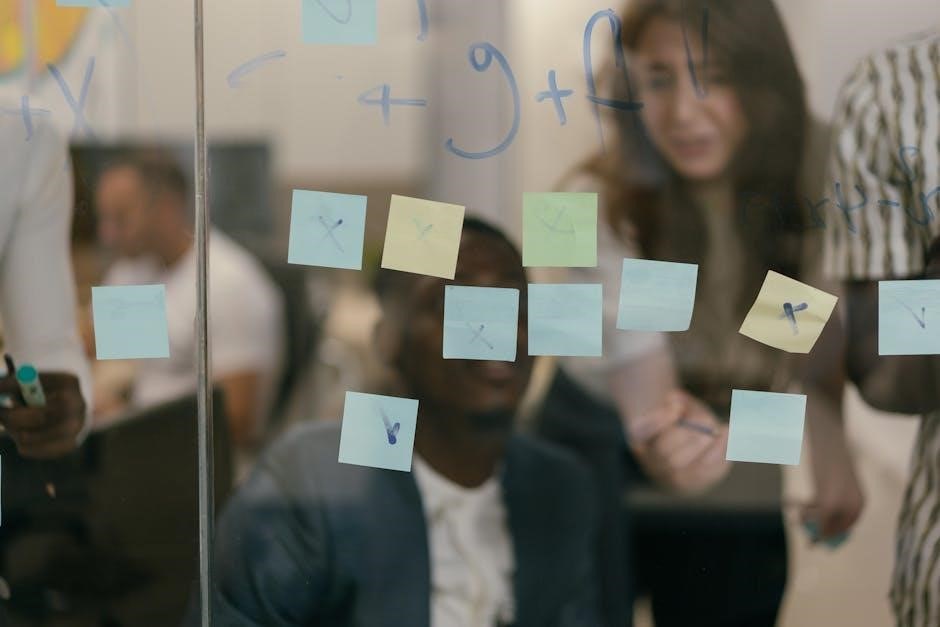Critical thinking is the systematic analysis of information to form judgments. It involves objective evaluation of arguments‚ identifying assumptions‚ and considering evidence to make informed decisions.

1.1 Defining Critical Thinking
Critical thinking is the systematic analysis and evaluation of information to form reasoned judgments. It involves objectively interpreting evidence‚ identifying assumptions‚ and testing arguments. This skill requires intellectual humility‚ open-mindedness‚ and a willingness to question assumptions. Critical thinking is not just about being skeptical but about engaging in a deliberate‚ structured process to uncover the truth. It is essential for making informed decisions‚ solving complex problems‚ and fostering clear communication. By cultivating this mindset‚ individuals can navigate information more effectively and arrive at well-supported conclusions in both personal and professional contexts.

1.2 Importance of Critical Thinking in Everyday Life
Critical thinking is essential for navigating everyday challenges‚ enabling individuals to make informed decisions and solve problems effectively. It helps in evaluating information‚ identifying biases‚ and avoiding misinformation. By fostering independence of thought‚ critical thinking promotes personal growth and self-confidence. In professional settings‚ it enhances decision-making‚ creativity‚ and collaboration. Cultivating this skill leads to better judgment‚ improved communication‚ and the ability to adapt to change. Ultimately‚ critical thinking empowers individuals to approach life’s complexities with clarity and confidence‚ making it a cornerstone of personal and professional success.

Key Components of Critical Thinking
Critical thinking involves identifying assumptions‚ analyzing arguments‚ and evaluating evidence. These components ensure logical reasoning‚ objective analysis‚ and informed decision-making.
2.1 Identifying Assumptions
Identifying assumptions involves recognizing the beliefs or premises that underpin arguments or statements. Critical thinkers examine these to determine if they are valid‚ relevant‚ or influencing conclusions unfairly. Often‚ assumptions are implicit‚ requiring careful analysis to uncover. By questioning them‚ individuals can avoid accepting information at face value and make more informed decisions. This step is crucial for objective reasoning and ensures that judgments are based on evidence rather than unexamined beliefs.
2.2 Analyzing Arguments
Analyzing arguments involves breaking down claims to assess their validity and logic. Critical thinkers identify the main claim‚ supporting evidence‚ and underlying assumptions. They evaluate whether the evidence is relevant‚ sufficient‚ and credible‚ and whether the logic is sound. This process also includes recognizing fallacies‚ such as emotional appeals or logical errors‚ which can weaken an argument. By systematically examining each component‚ individuals can determine the strength of the argument and make reasoned judgments. This skill is essential for evaluating information objectively and avoiding persuasion based on flawed reasoning.
2.3 Evaluating Evidence
Evaluating evidence is a cornerstone of critical thinking‚ involving the assessment of data‚ facts‚ and testimonies to support or refute claims. Critical thinkers examine the credibility of sources‚ ensuring they are reliable and unbiased. They also consider the quality and relevance of evidence‚ determining whether it directly pertains to the argument. Additionally‚ evidence is cross-checked for consistency and accuracy. Using tools like Boolean operators can help locate credible sources efficiently. By scrutinizing evidence‚ individuals can distinguish between well-supported arguments and those lacking substantial backing‚ fostering informed decision-making and objective reasoning.

Developing Effective Search Strategies
Effective search strategies involve using keywords‚ Boolean operators‚ and advanced techniques to refine results. Identifying relevant terms and combining them logically ensures precise and efficient information retrieval.
3.1 Using Keywords and Search Terms
Identifying effective keywords is crucial for efficient information retrieval. Brainstorm relevant terms related to your topic‚ focusing on nouns and short phrases. Keywords are flexible and can be combined using Boolean operators to refine searches. Unlike subjects‚ which are predefined‚ keywords allow for creative customization. However‚ keyword searches may yield broader results‚ requiring careful filtering. Databases and engines scan for these terms anywhere in the record‚ making precision essential. Avoid adjectives and verbs for clearer focus. By selecting meaningful words‚ you enhance the accuracy of your search outcomes‚ ensuring relevance and reducing irrelevant data.
3.2 Boolean Operators for Narrowing Search Results
Boolean operators—AND‚ OR‚ and NOT—are essential tools for refining search results. AND narrows searches by combining keywords‚ ensuring both terms appear. OR broadens results by including either term‚ while NOT excludes specific words. These operators help tailor searches to specific needs‚ reducing irrelevant information. Using them in capitalized form in search bars or advanced settings enhances precision. For example‚ “critical thinking AND education” finds focused results‚ while “psychology OR neuroscience” expands possibilities. Mastering Boolean operators streamlines research‚ saving time and improving the quality of retrieved information.
3.3 Advanced Search Techniques
Advanced search techniques enhance research efficiency by refining results. Use quotation marks for exact phrases‚ site-specific searches to limit results‚ and filters for date or file type. Employing these methods ensures focused outcomes‚ saving time and improving information quality. These techniques are vital for critical thinking‚ enabling better evaluation of sources and informed decision-making. By mastering advanced searches‚ individuals can locate credible data swiftly‚ fostering deeper analysis and discernment in their inquiries.
Evaluating Sources and Information
Evaluating sources involves assessing credibility‚ identifying bias‚ and verifying information through multiple sources to ensure accuracy and reliability in critical thinking and decision-making processes.
4.1 Assessing Credibility of Sources
Assessing credibility involves evaluating the reliability and trustworthiness of sources. Use keywords and Boolean operators to refine searches‚ ensuring sources are authoritative and relevant. Check for author expertise‚ publication date‚ and peer-reviewed status to gauge credibility. Be wary of bias or misleading information. Verifying facts through multiple sources enhances accuracy. Credible sources are essential for informed decision-making in critical thinking. Always consider the purpose and audience of the information to contextualize its reliability.

4.2 Identifying Bias and Misinformation
Identifying bias and misinformation requires critical evaluation of sources. Bias can stem from ideological perspectives‚ confirmation bias‚ or selective presentation of information. Misinformation often involves factual errors or outdated data. To detect bias‚ look for emotional language‚ one-sided arguments‚ or unsupported claims. Cross-referencing information across multiple credible sources helps verify accuracy. Be cautious of sources with unclear authorship or affiliations‚ as they may lack accountability. Recognizing these red flags enhances your ability to discern reliable information and avoid being misled by biased or false content.
4.3 Verifying Information Through Multiple Sources
Verifying information through multiple sources is essential for ensuring accuracy and reliability. Cross-referencing data across credible sources helps identify inconsistencies or errors. Start by identifying reputable sources‚ such as peer-reviewed journals or well-established organizations. Use Boolean operators and advanced search techniques to locate relevant materials. Check publication dates to ensure information is up-to-date. Look for consensus among sources to confirm facts. Be cautious of biased or unverified sources‚ as they may distort information. By systematically verifying details‚ you can build a well-supported and accurate understanding of any topic.

Overcoming Cognitive Biases
Recognizing biases and employing strategies like evidence analysis‚ open-mindedness‚ and skepticism can help mitigate their impact on decision-making and judgment. Practice mindfulness and critical reflection to enhance objectivity.
5.1 Recognizing Common Cognitive Biases
Cognitive biases are systematic patterns of deviation from normative judgment‚ often caused by the mind’s tendency to simplify complex decisions. Common biases include confirmation bias‚ where individuals favor information that confirms their preexisting beliefs‚ and anchoring bias‚ which involves relying too heavily on the first piece of information encountered. Other notable biases include the availability bias‚ where judgments are influenced by how easily examples come to mind‚ and the sunk cost fallacy‚ where decisions are based on past investments rather than future outcomes. Recognizing these biases is the first step in mitigating their impact on critical thinking and decision-making.
5.2 Strategies to Mitigate Confirmation Bias
To reduce confirmation bias‚ actively seek out diverse perspectives and evidence that challenge your beliefs. Practice active listening by engaging with opposing viewpoints without immediate judgment. Encourage open-mindedness by questioning your assumptions and considering alternative interpretations. Additionally‚ foster critical discussions with others to expose yourself to differing ideas. Using decision-making frameworks can also help structure your thinking objectively. By intentionally broadening your information sources and remaining receptive to new insights‚ you can make more balanced and informed decisions‚ reducing the influence of confirmation bias in your critical thinking process.

5.3 Encouraging Open-Mindedness
Open-mindedness is a cornerstone of critical thinking‚ involving the willingness to consider diverse perspectives and entertain ideas that challenge your existing beliefs. To foster open-mindedness‚ engage in active listening and seek out multiple viewpoints‚ even those that contradict your own. Avoid making hasty judgments and remain receptive to new information. Ask questions to clarify others’ positions and reflect on your own assumptions. By embracing intellectual humility and recognizing the complexity of issues‚ you can cultivate a mindset that values exploration over certainty‚ leading to more nuanced and informed decision-making.
Applying Critical Thinking in Real-Life Scenarios
Critical thinking enhances decision-making‚ problem-solving‚ and communication in everyday life. It helps evaluate information‚ identify biases‚ and make informed choices‚ fostering clarity and effectiveness in real-world situations.
6.1 Critical Thinking in Decision-Making
Critical thinking is essential for effective decision-making. It involves analyzing options‚ evaluating evidence‚ and considering potential consequences. By identifying assumptions and biases‚ individuals can make more objective choices. Structured approaches‚ such as weighing pros and cons or using decision matrices‚ enhance clarity. Critical thinking also encourages questioning assumptions and exploring alternative perspectives‚ leading to well-rounded decisions. Regular practice of these skills fosters confidence and accuracy in decision-making processes.

6.2 Problem-Solving Using Critical Thinking
Critical thinking is a powerful tool for effective problem-solving. It involves systematically analyzing challenges‚ identifying key issues‚ and evaluating potential solutions. By breaking down complex problems into manageable parts‚ individuals can better understand the root causes. Critical thinking encourages the generation of multiple solutions and the assessment of their pros and cons. It also promotes the use of evidence-based reasoning to select the most viable options. Regular practice enhances creativity‚ objectivity‚ and the ability to approach problems from diverse angles‚ leading to more innovative and effective solutions.
6.3 Enhancing Communication Through Critical Thinking
Critical thinking significantly improves communication by fostering clarity and precision in expression. It encourages individuals to organize their thoughts logically‚ ensuring messages are conveyed effectively. By evaluating evidence and arguments‚ communicators can present their ideas more persuasively. Critical thinking also promotes active listening‚ as it involves analyzing others’ perspectives and responding thoughtfully. This skill helps identify and address misunderstandings‚ leading to more productive conversations. Additionally‚ critical thinking enables adaptability in communication‚ allowing individuals to tailor their approach to different audiences and contexts‚ enhancing overall understanding and collaboration.
